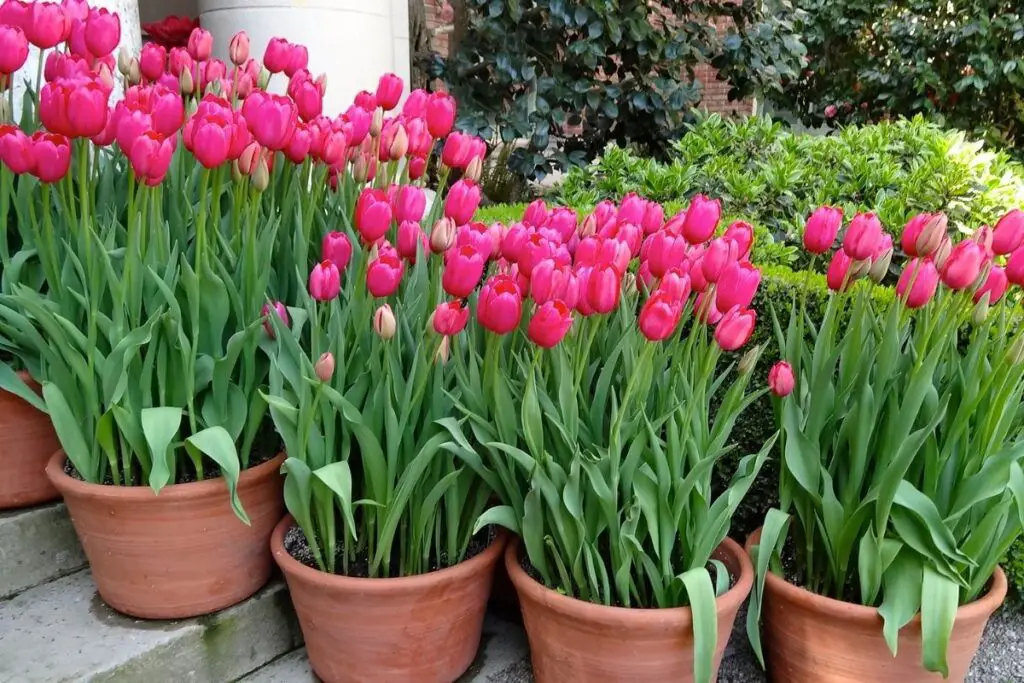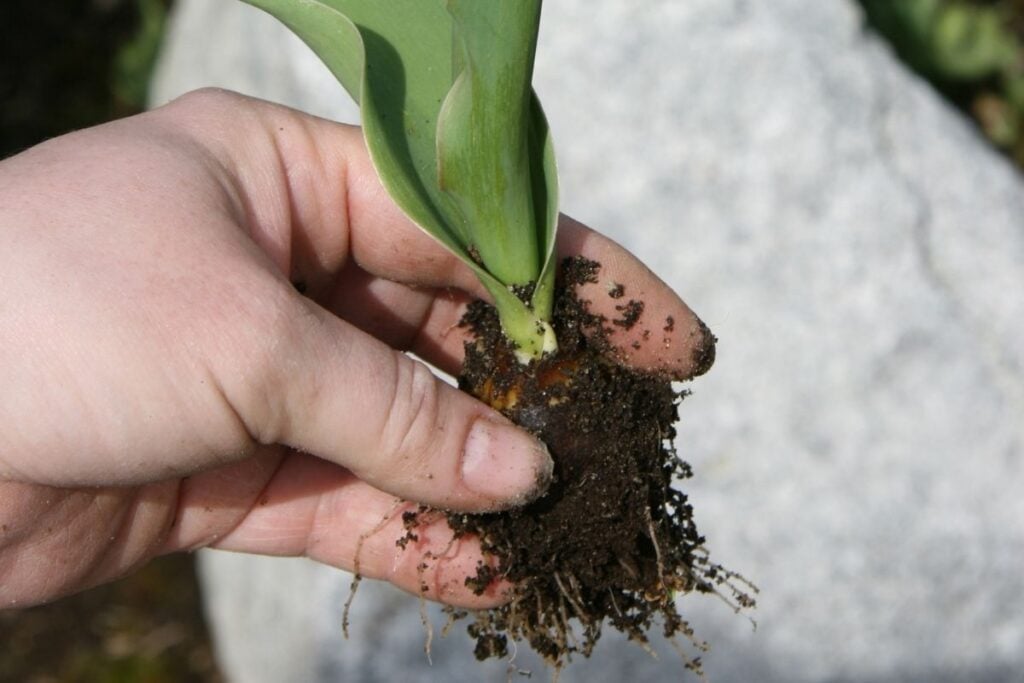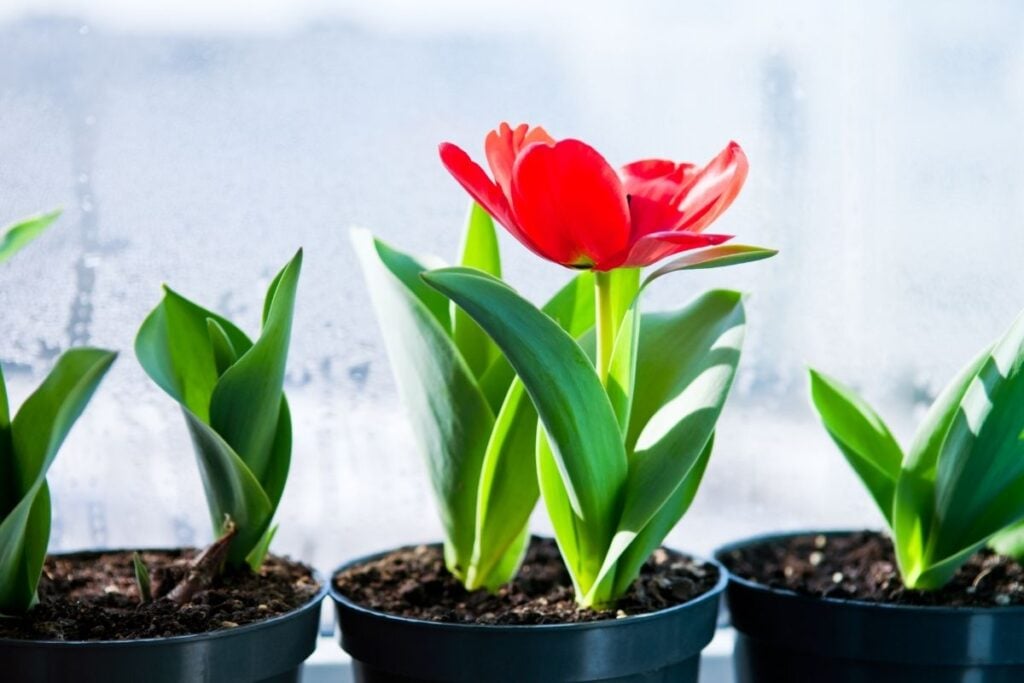For several years, the most iconic spring bloom, tulips elegant charm has attracted gardeners of every skill level. But whether tulips can be grown indoors or outdoors is a question that comes to the mind of many enthusiasts, and that is what we will address today.
Are tulips inside or outside plants? Let’s find out.
As a general rule, tulips can be grown outdoors if you live within USDA zone 3-8 for all other areas; you need to grow them indoors. If grown indoors, you need to provide them with lots of light and temperature between 35-50°F for them to bloom. Thus, It is preferred to grow them outdoors.
This article will cover all the details that you need to know about having the tulips both outside and inside.

Should tulips be inside or outside?
As per the Missouri Botanical Garden, tulips grow best outside in the full sun. But, they can adapt well inside and even showcase their flowers.
Several tulip species are meant to grow indoors, so make sure you research your tulip varieties before deciding whether to grow them inside or outside.
Now, let’s delve into how we can care for tulips both indoors and outdoors.
Choosing the tulips
While choosing the tulips to plant in your garden, you have to make sure the bulbs aren’t soft, moldy, flabby, or with a missing paper cover. They have an embryo flower tucked away inside, awaiting growth.
In the late summer, you should purchase firm and fat tulip bulbs for planting.
Then, store the tulip bulbs in paper bags instead of plastic and keep them in a cool place before planting them. Since tulips are highly eager to grow, they will sprout the leaves immediately once you plant them.
According to the research of the National Gardening Association, small tulip species like the humilis tulips are better suited for indoors as they will result in a dramatic flower display in a minimum space.
Try your best to look for tulip bulbs labeled as miniature/dwarf varieties. But remember that with the right conditions and care, any tulip can grow well in your household.
The taller tulip species, especially the ones with large flowers and elongated stems, are too top-heavy. As a result, they will fail to maintain an upright position in pots and might topple off.
The standard and popular cultivars from the Triumph Group, Parrot Group, and the Darwin Hybrid Group, with their big flower size, are best grown outdoors in the garden.
The varieties like ‘Acropolis,’ ‘American Dream,’ and ‘ Light and Dreamy’ bloom almost for five years and grow up to a height of 28 inches.
How to grow and care for tulips outside?

Growing tulips in the garden are relatively simple if you follow the instructions with complete attention to detail.
Looking for gardening supplies? We have tested 100's of products before recommending them to you guys. Check out our best pick below:
| Image | Gardening Supplies | Best Price? |
|---|---|---|
 Top
Top Top
Top | Raised Garden Bed Kit | Check On Amazon |
 | XLUX Soil Moisture Meter, Plant Water Monitor, Soil Hygrometer Sensor for Gardening, Farming, Indoor and Outdoor Plants, No Batteries Required | No Results |
 Top
Top Top
Top | 82 Pcs Garden Tools Set and Extra Succulent Tools Set | Check On Amazon |
 | Joeys Garden Expandable Garden Hose with 8 Function Hose Nozzle, Lightweight Anti-Kink Flexible Garden Hoses, Extra Strength Fabric with Double Latex Core, (50 FT, Black) | No Results |
 Top
Top Top
Top | Dual Chamber Compost Tumbler | Check On Amazon |
 Top
Top Top
Top | Sunnyglade Plant Stakes | Check On Amazon |
 Top
Top Top
Top | Organic Cold Pressed Neem Seed Oil | Check On Amazon |
 Top
Top Top
Top | Mighty Mint Gallon :-Insect and Pest Control Peppermint Oil | Check On Amazon |
 Top
Top Top
Top | Scotts DiseaseEx Lawn Fungicide | Check On Amazon |
 Top
Top Top
Top | Jacks Classic 20-20-20 All Purpose Fertilizer | Check On Amazon |
 Top
Top Top
Top | 30,000 Seeds Pollinator Attracting Wildflower Mixture | Check On Amazon |
 Top
Top Top
Top | Survival Vegetable Seeds Garden Kit-Over 16,000 Seeds | Check On Amazon |
Timing
Fall or autumn is the ideal time to plant tulip bulbs outside when soil temperatures are between the 50 and 60°F range. This is because flower bulbs require a cold period to develop sturdy roots and get ready for spring.
You can also wait till the temperatures are colder than 60°F. Get to planting as soon as you feel the chill in the air around October/ November, six weeks before the first frost.
If you live in an area with no cold winters, buying pre-chilled bulbs is a good option. This way, you will avoid the peak hoarding season of squirrels and chipmunks as well.
Soil
Soil preparation plays a vital role in caring for tulips. The tulip bulbs can easily succumb to root rot if they are planted in too wet soil. Thus, make sure to avoid the use of soggy, heavy, and clay soil at all times.
Tulips need extremely well-drained, crumbly soil for their survival and healthy growth. The soil outside should be loose enough to turn around and work with efficiently.
Also read: What Kind Of Soil Is Good For Tulips? (Best Soil Mix)
Spacing
It is necessary to dig out the entire bed in the garden to plant several tulip plants together.
You can create individual holes only for planting a few tulips. The standard depth should be three times the diameter of the bulb. This usually translates to a depth of about 4 to 8 inches.
Garden designers recommend the plantation of tulip bulbs in groups of 50 or more.
This will come down to about 10-12 bulbs per square foot. There should be sufficient spacing of about 4.5’’ apart between all the bulbs to prevent a fight for nutrients and keep fungal diseases at bay.
But, you can put a space of 2” to 3” inches if you desire a full look in the garden. Thus, position the tulip bulbs securely with their pointy end facing up and slide off some soil to cover them.
Since tulips always sprout and bloom early, you can plant them under trees and shrubs that will grow leafy to create a shady environment.
There are quite a few patterns for you to choose from: cluster arrangement for blossoms in a woodland area or planting rows of bulbs in an alternating formal manner for diagonal lines.
Light
Choose a location where the plant bulbs will receive full sun outside. This will ensure that your tulip reaches its maximum flower size and height.
Tulips perform well in part shade conditions and half-day sun as well. In warmer climates, the flowers will live longer if they are protected from the scorching afternoon sun.
Also read: How Much Sunlight Do Tulips Need? (Tulip Light Needs)
Water
After planting them outside, you must water the tulip bulbs thoroughly.
It is essential to water once a week for the first-month post-planting to aid the growth of roots and settling of bulbs. Then, you should withhold watering until spring.
But if the region gets enough rain, there is no need for watering at all. The tulips will last longer, as much as you can replicate the dry conditions in Central Europe and Eastern Asia.
When you find the leaves appearing in spring, start watering again and wait for the blooms to surprise you.
Also read: How Often Do Tulips Need To Be Watered? (Tulip Watering Needs )
Fertilizer
Before planting, remember to add peat, bone meal, compost, or granular fertilizer to the tulip plant bed. Repeat this cycle in the following spring before sprouting.
Also read: What Is The Best Fertilizer For Tulips? (Organic+Inorganic)
Growing tulips inside

When the weather outside turns too cold and fierce, many consider the idea of growing tulip bulbs inside. The process of growing tulips indoors is known as forcing.
With some planning, you can grow tulips in pots to add a burst of greenery and color to your home.
Keep reading to gather more information about how to force tulip bulbs in the winter.
1. Since tulips are not sold with the purpose of ‘forcing,’ most of the bulbs will need adequate preparation. Select the biggest tulip bulbs you can find, free of blemishes.
2. Next, place them for 12-16 weeks in a cool, dark place like an unheated garage, basement, or even the vegetable compartment in the fridge. The suitable temperature should be between 35-45°F.
3. Use a pot with a broad bottom like ceramic and azalea pots. These pots aren’t likely to tip over when the plants grow in size. When dealing with planting bulbs in containers, get a pot or box with suitable drainage holes.
If there is an absence of holes, you can create some yourself. Also, get a single layer of pea-sized gravel to line the bottom of the pot before setting it in the potting medium.
4. Fill the pots with potting soil that is slightly acidic and well-draining to about 4 inches below the rim. Keep the bulbs together closely, with no more than a gap of 2 inches.
5. Then, force the tulip bulbs firmly on top of the soil with the pointy end up. Plant the bulb so that its flat side touches the inner rim of the pot as the largest leaves come out of this side.
6. Light watering once per week can work wonders. But once the leaves begin sprouting, they will require bright but indirect light.
Tulips crave the full sun. That is why the pots should be positioned near a sunny east or south-facing window at room temperatures. This will help them get an abundant supply of light before the blooms fully emerge.
How to care for tulips inside?

After completing the forcing process, you need to care for the tulips in ways similar to a houseplant.
- Water the plants only when the soil in the pot is dry.
- Do not rush to cut the foliage once the tulips have finished blooming, as the leaves will produce nutrients via photosynthesis that the bulbs will need for their next growing season. Once the leaves show signs of spotting and decay, you can cut them.
- You can propagate the tulips easily in the fall by lifting and dividing the offset baby bulbs attached to the mother bulb.
- To protect the tulips from the attack of hungry vermins, plant your tulips near daffodils, a flower that vermins seldom bother. You can also line the tulip bed with a wide-gauge wire mesh and then place the bulbs over them and backfill with soil.
- Since it’s impossible to maintain spacing in the pots, you have to plant the tulips more closely than in the garden. You need to ensure the bulbs don’t touch each other and cause root rot.
- Plant the tulip bulbs in layers in a deep pot, with the earlier blooming ones at the top and later blooming varieties at the bottom.
Final thoughts
No matter where you grow your tulips, it will be a rewarding experience. Tulips are pretty resilient and don’t need much tending.
Thus, try your best not to fuss over your tulip bulb outside or inside. Overwatering or too much landscaping can disrupt their natural pace of growth.
Wherever you decide to grow your tulips, inside the house or outside the garden, you need to take care of the plants according to their basic requirements.
Source: Wikipedia, North Dakota Stae University, The Royal Horticultural Society.
